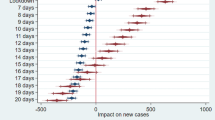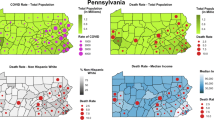Abstract
To examine trends in predictors of HIV-related mortality among cohorts of persons living with AIDS (PLWA) in New York City (NYC), nine calendar year-specific cohorts of PLWA were created from 1993 to 2001. Cohorts were defined as persons who had been alive at any time during that year and had been diagnosed with AIDS before the end of that year. Predictors of death because of HIV-related causes of death were assessed by examinnng year-specific, stratified death rates per 1,000 PLWA and adjusted relative risks (RRs) from proportional hazards models. We conducted an analysis of AIDS surveillance data PLWA in NYC between 1993 and 2001. Univariate and multivariate Cox proportional hazards models were constructed for each calendar year cohort to evaluate trends in the RR of HIV-related death over the subsequent 5 years, adjusting for sex, reace/ethnicity, age, transmission risk borough of residence, category of AIDS diagnosis [opportunistic illness (OI) or CD4 count <200 cells/μL], time since AIDS diagnosis, and CD4 count at time of AIDS diagnosis. Death rates due to all causes and HIV-related causes declined substantially during 1993–1997 and then stabilized in all subgroups of PLWA between 1998 and 2001. Beginning in 1995, differences in survival emerged in some subgroups, such that by 2001 (1) injecting drug users (IDUs) had poorer survival compared with men who have sex with men (MSM) [RR2001=2.1, 95% confidence intervals (95% CI)=1.8–2.4]; (2) black and Hispanic PLWA had a significantly higher risk of death than white PLWA (RR2001=1.4, 95% CI=1.2–1.6, RR2001=1.2, 95% CI=1.1–1.4, respectively, and (3) PLWA aged 60 and above had poorer survival compared with younger persons (RR2001=2.4, 95% CI=1.9–3.0), after adjustment for other factors. The observed disparities that began to emerge in 1995 may be attributable to differential effects of, access to, or usage of highly active antiretroviral therapy (HAART). More targeted studies are needed to determine why such disparities have emerged.
Similar content being viewed by others
References
Moore RD, Chaisson RE. Natural history of HIV infection in the era of combination antiretroviral therapy. AIDS. 1999;13:1933–1942.
Perez-Hoyos S, del Amo J, Muga R et al. Effectiveness of highly active antiretroviral therapy in Spanish cohorts of HIV seroconverters: differences by transmission category. AIDS. 2003;17:353–359.
Baillargeon J, Borucki M, Black SA, Dunn K. Determinants of survival in HIV-positive patients. Int J STD AIDS. 1999;10:22–27.
Baillargeon J, Grady J, Borucki MJ. Immunological predictors of HIV-related survival. Int J STD AIDS. 1999;10:467–470.
Fordyce EJ, Blum S, Shum R, Singh TP, Chiasson MA, Thomas P. The changing AIDS epidemic in New York City: a descriptive birth cohort analysis of AIDS incidence and age at diagnosis. AIDS. 1995;9:605–610.
Fordyce EJ, Shum R, Singh TP, Forlenza S. Economic and geographic diversity in AIDS incidence among HIV exposure groups in New York City. AIDS Public Policy J. 1998 Fall;13:103–114.
Fordyce EJ, Williams RD, Surick IW, Shum RT, Quintyne RA, Thomas PA. Trends in the AIDS epidemic among men who reported sex with men in New York City. AIDS Educ Prev. 1995;7(suppl 5):3–12.
New York City Department of Health HIV Epidemiology Group. 25 years of HIV in New York City: lessons from surveillance. J Urban Health. 2001;78:669–678.
Des Jarlais DC, Friedman SR, Novick DM, et al.. HIV-1 infection among intravenous drug users in Manhattan, New York City, from 1977 through 1987. JAMA. 1989;261:1008–1012.
Mocroft A, Vella S, Benfield TL, et al. Changing, patterns of mortality across Europe in patients infected with HIV-1. Euro SIDA Study Group. Lancet. 1998;352:1725–1730.
Egger M, Hirschel B, Francioli P, et al. Impact of new antiretroviral combination therapies in HIV infected patients in Switzerland: prospective multicentre study. Swiss HIV Cohort Study. BMJ. 1997;315:1194–1199.
Palella FJ Jr, Delaney KM, Moorman AC, et al. Declining morbidity and mortality among patients with advanced human immunodeficiency virus infection. HIV Outpatient Study Investigators. N Engl J Med. 1998;338:853–860.
Hogg RS, Health KV, Yip B, et al. Improved survival among HIV-infected individuals following initiation of antiretroviral therapy. JAMA. 1998;279:450–454.
Detels, R, Munoz A, McFarlane G, et al. Effectiveness of potent antiretroviral therapy on time to AIDS and death in men with known HIV infection duration. Multicenter AIDS Cohort Study Investigators. JAMA. 1998;280:1497–1503.
Schwartz S, Li W. Summary of Vital Statistics 2001: The City of New York. New York, NY: New York City Department of Health and Mental Hygiene; 2003.
Centers for Disease Control and Prevention. Guidelines for national human immunodeficiency virus case surveillance including monitoring for human immunodeficiency virus infection and acquired immunodeficiency syndrome. MMWR Recomm Rep. 1999;48:1–27, 29–31.
1993 revised classification system for HIV infection and expanded surveillance case definition for AIDS among adolescents and adults. MMWR Recomm Rep. 1992;41:1–19.
Greenberg AE, Hindin R, Nicholas AG, Bryan EL, Thomas PA. The completeness of AIDS case reporting in New York City. JAMA. 1993;269:2995–3001.
CDC. HIV/AIDS Surveillance Report. Vol. 13. Atlanta, GA: Centers for Disease Control and Prevention; 2001. No. 2.
Schmidt MA Mokotoff ED. HIV/AIDS surveillance and prevention: improving the characterization of HIV transmission. Public Health Report. 2003;118:197–204.
CDC. Implementation of named HIV reporting — New York City, 2001. MMWR Morb Mortal Wkly Rep. 2004;52:1248–1252.
Lee LM, Karon JM, Selik R, Neal JJ Fleming PL. Survival after AIDS diagnosis in adolescents and adults during the treatment era, United States. JAMA. 2001;285:1308–1315.
Survival after introduction of HAART in people with known duration of HIV-1 infection. The CASCADE collaboration. Concerted action on seroconversion to AIDS and death in Europe. Lancet. 2000;355:1158–1159.
Rapiti E, Porta D, Forastiere F, Fusco D, Perucci CA Socioeconomic status and survival of persons with AIDS before and after the introduction of highly active antiretroviral therapy. Lazio AIDS Surveillance Collaborative Group. Epidemiology. 2000;11:496–501.
McFarland W, Chen S, Hsu L, Schwarcz S, Katz M. Low socioeconomic status is associated with a higher rate of death in the era of highly active antiretroviral therapy San Francisco. J Acquir Immune Defic Syndr. 2003;33:96–103.
Cunningham WE, Markson LE, Andersen RM, et al. Prevalence and predictors of highly active antiretroviral therapy use in patients with HIV infection in the United States. HCSUS consortium. HIV cost and services utilization. J Acquir Immune Defic Syndr. 2000;25:115–123.
Kitahata MM, Koepsell TD, Deyo RA, Maxwell CL, Dodge WT, Wagner EH. Physicians’ experience with the acquired immunodeficiency syndrome as a factor in patients’ survival. N Engl J Med. 1996;334:701–706.
Hogg RS, Yip B, Chan KJ, et al. Rates of disease progression by baseline CD4 cell count and viral load after initiating triple-drug therapy. JAMA. 2001;286:2568–2577.
Shapiro MF, Morton SC, McCaffrey DF, et al. Variations in the care of HIV-infected adults in the United States: results from the HIV Cost and Services Utilization Study. JAMA. 1999;281:2305–2315.
Moore RD, Stanton D, Gopalan R, Chaisson RE. Racial differences in the use of drug therapy for HIV disease in an urban community N Engl J Med. 1994;330:763–768.
Moore AL, Kirk O, Johnson AM, et al. Virologic, immunologic, and clinical response to highly active antiretroviral therapy: the gender issue revisited. J Acquir Immune, Defic Syndr. 2003;32:452–461.
Chaisson RE, Keruly JC, Moore RD. Race, sex, drug use, and progression of human immunodeficiency virus disease. N Engl J Med. 1995;333:751–756.
Prins M, Robertson JR, Brettle RP, et al. Do gender differences in CD4 cell counts matter? AIDS. 1999;13:2361–2364.
Junghans C, Ledergerber B, Chan P, Weber R, Egger M. Sex differences in HIV-1 viral load and progression to AIDS. Swiss HIV Cohort Study. Lancet. 1999;353:589–590. author reply 590–591.
Easterbrook PJ, Keruly JC, Creagh-Kirk T, Richman DD, Chaisson RE, Moore RD. Racial and ethnic differences in outcome in zidovudine-treated patients with advanced HIV disease. Zidovudine Epidemiology Study Group. JAMA. 1991;266:2713–2718.
del Amo J, del Romero J, Barrasa A, et al. Factors, influencing HIV progression in a seroconverter cohort in Madrid from 1985 to 1999. Sex Transm Infect. 2002;78:255–260.
Sackoff JE, McFarland JW, Shin SS. Trends in prescriptions for highly active antiretroviral therapy in four New York City HIV clinics. J Acquir Immune Defic Syndr. 2000;23:178–183.
Messeri P, Lee G, Abramson DM, Aidala A, Chiasson MA, Jessop DJ. Antiretroviral therapy and declining AIDS mortality in New York City. Med Care. 2003;41:512–521.
Lucas GM, Cheever LW, Chaisson RE, Moore RD. Detrimental effects of continued illicit drug use on the treatment of HIV-1 infection. J Acquir Immune Defic Syndr. 2001;27:251–259.
Obiri GU, Fordyce EJ, Singh TP, Forlenza S. Effect of HIV/AIDS versus other causes of death on premature mortality in New York City. Am J Epidemiol. 1998;147:840–845.
Author information
Authors and Affiliations
Corresponding author
Rights and permissions
About this article
Cite this article
Nash, D., Katyal, M. & Shah, S. Trends in predictors of death due to HIV-related causes among persons living with AIDS in New York City: 1993–2001. J Urban Health 82, 584–600 (2005). https://doi.org/10.1093/jurban/jti123
Issue Date:
DOI: https://doi.org/10.1093/jurban/jti123




